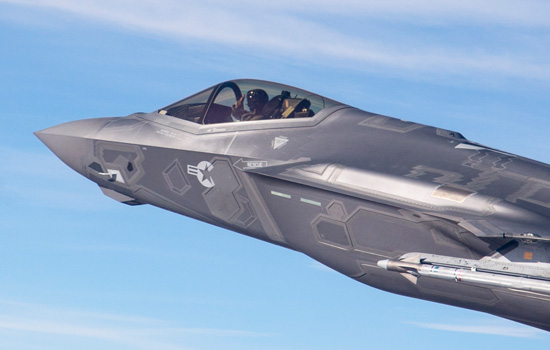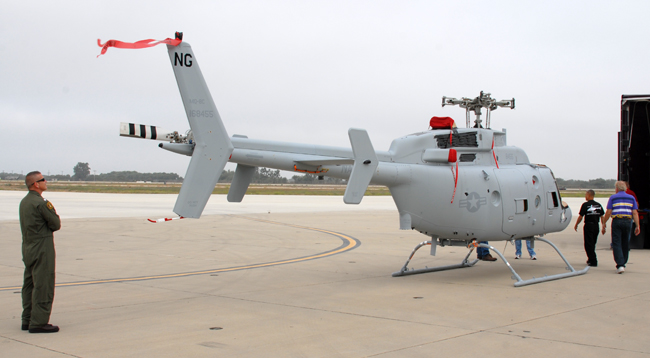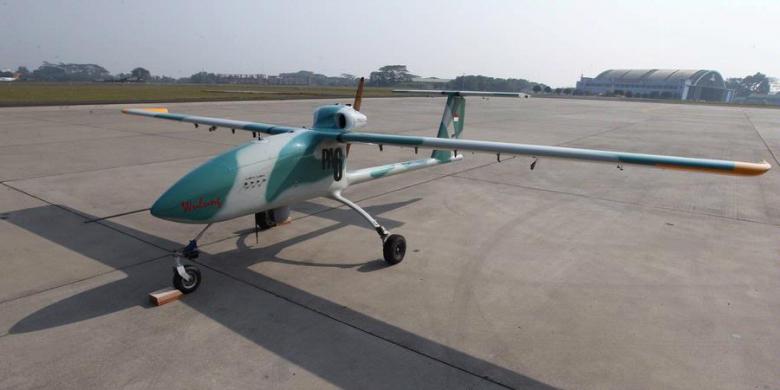
F-35A flying with an AIM-9X Super Sidewinder Air/Air missile carried on the outer pylon. Typically the F-35 will carry four AIM-120D missiles in the weapon’s bay, on stealth missions. Photo: Lockheed Martin
Though late to sign on to the network of nations purchasing the F-35 Joint Strike Fighter, Israel will be the first international customer to operate the fifth-generation fighter, Aviation Week’s David Eshel reports. “Israel will become the first non-U.S. operator of the F-35 in the world,” said Steve O’Bryan, Lockheed Martin’s vice president for F-35 program integration and business development in an interview at the Paris air show. The first F-35I combat squadron is expected to achieve initial operational capability in 2018. Eight other countries have already committed to the program with firm contracts.
“The F-35 fighters going into service with these users will use different initial versions that will be upgraded later into the latest version, as it becomes available,” O’Bryan said. That mean F-35s will be tailored to individual nations, he says. “Specific capabilities developed for certain users will remain exclusive, and open to other users only with the original user’s consent. For example, the software blocks pertaining to the Norwegian anti-ship missile will not be available to other F-35 operators except Norway, unless it decides to sell those missiles to one of the F-35 users. The same goes to the Rafael Spice 1000. Similarly, the advanced electronic warfare, data links and specific software modes developed for the Israeli air force will remain unique to Israel and not delivered to any other user. These capabilities will also be fully integrated with the aircraft capabilities, adhering to the stealth characteristics of the aircraft, particularly, at specific apertures cleared for the Israeli systems integration in the lower fuselage and leading edge,” he said.
The first Israeli pilots plan to arrive at Eglin AFB, Fla., for training on the F-35A in early 2016 (Aviation Week, 17 June 2013). The first aircraft is tentatively set to be delivered to the Israel air force toward the end of that year, and arrive in Israel in 2017. These F-35Is will be produced under Low Rate Initial Production (LRIP) lots 8, 9 and 10. By that time, all 19 aircraft included under the $2.75 billion order will be delivered to the IAF under the current five-year plan.
A follow-on order for more F-35Is is expected in 2018, under the next five-year plan. As the new fighter enters full-production rate, volumes are expected to increase, leading to proportionally lowering cost, expected to drop below $85 million in then-year dollars.
Financing of this follow-on procurement is already under discussion with the U.S. Jerusalem is seeking creative ways for Washington’s agreement to guarantee payment for these planes, including the foreign military sales budget allocated annually to Israel. If this concept is approved, Israel will be required to pay for the interest but will be able to commit willingly to follow-on orders and receive the second squadron immediately after the first is delivered.
“With the F-35 Israel is expected to receive the AIM-9X short-range air/air missile (AAM) and the Raytheon AIM-120 AMRAAM Beyond Visual Range (BVR) AAM,” O’Bryan added. The F-35 currently carries the Raytheon AIM-9X Block at the outboard under-wing stations, in non-stealth configuration, as the current Block I missiles cannot be carried internally. This shortcoming will be corrected in Block II, which is to follow soon.
Nevertheless, the optimal weapon carriage for the F-35 comprises exclusively the AMRAAM missiles, enabling the fighter to maximize its “see-first, shoot-first, kill-first” strategy. The next generation BVR-AAM will offer both active and passive guidance techniques, offering effective intercept ranges in excess of 100 km. This makes part of the argument not to include the Rafael Python V missile in the aircraft configuration; the next generation Python VI will be designed to fit the new fighter. Yet, according to IAF sources, a decision whether to use a derivative of the Stunner or a brand-new AAM has yet to be made.
F-35s are prepared to fight air combat as a “networked formation,” sharing all information between all members at all time. The data link used for this process, called MADL, will also be available to all F-35 operators. In addition, Harris Multi-Function Advanced Data-Link (MADL) terminals could be installed on certain support elements, to extend information sharing and update the data available to the stealthy F-35 formation. In addition, the F-35 is now offering Link-16 connectivity and would obviously include a satellite link as well, providing secure, low-probability-of-detection communications on extended range missions.
In August 2012 Lockheed Martin received a $206 million award from the U.S. Navy Naval Air Systems Command, covering the development and integration of Israeli systems in the F-35A. Part of a larger package, the integration support agreement with Lockheed Martin covers a $450 million program to enhance Electronic Warfare (EW) equipment on the F-35, and integrate Israeli-unique systems beginning in 2016 (Aviation Week, Aug. 16, 2012).
“The advantage of this F-35 for the Israel air force is not about higher performance or a specific weapon capacity, but the ability to understand the battlespace, identify, locate targets from standoff range and neutralize them before being engaged,” Brig. Gen. Hagi Topolanski, Chief of Air Staff and Deputy Israeli Air Force Commander, told Aviation Week in a recent interview (Aviation Week subscription required). “These capabilities are meaningful in dealing with modern fighter aircraft and advanced SAMs. While the F-35 has its limitations, it can take on and win against any threat currently available in-theater. Its ability to independently collect, assess and process a battlespace situational picture, and strike those targets by itself, from standoff range, is providing a qualitative edge over anything the enemy can confront with, in the foreseeable future.”
Israel insisted upon a number of requirements throughout the procurement negotiations on the F-35I. Those included the adaptation of the baseline F-35A including all its systems, to the Israeli air force’s operational environment, which will require some necessary additions. “Our F-35I will be equipped with our specific networks, armament and electronic warfare, among them the Spice autonomous EO guided weapon. It will also carry the AIM-9X2 air-to-air missile, which will become the first platform in the IAF to employ this advanced air-to-air missile. We also plan to continue and pursue the development of future air-to-air missiles; we are still evaluating the cost/performance trade-off between a common air-to-air and air-to-ground missile and a dedicated AAM design,” Topolanski explained. “Assuming the F-35 will offer the capabilities it is planned to deliver, it will bring a new dimension to air battles as we know today.”
One of the advantages of the F-35 is the aircraft’s ability to fly long-range missions with internal weapons, accelerate faster and maintain higher speed, compared to current F16s or F-15s or any of the opposing force combat aircraft (flying with internal fuel). To further extend the F-35’s range, Lockheed Martin is exploring an innovative concept from Israel, of using unique drop tanks, developed by Elbit Systems Cyclone. Designed in a similar concept to the F-22 under-wing drop tanks, these tanks, each containing 425 gal. of fuel, will use special attachment pylons that would completely separate from the wing, regaining full stealth capability after separation. An additional 900 gal. of fuel will significantly extend the F-35I range, enabling the IAF to operate its new stealth fighter at the “outer ring” of operation without mandatory aerial refuelling.
This article was first published by Aviation Week



































